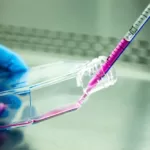What do you mean by benchtop centrifuge?
A small lab-grade centrifuge is known as a benchtop centrifuge which is suitable for use on a laboratory workbench or counter. Centrifugal force is commonly utilized to separate substances in a liquid or solid mixture. This type of centrifuge is extensively used in medical, scientific, and industrial experiments to isolate cells or cell components, separate blood components, purify proteins and nucleic acids, and prepare samples for analysis.
Also Read: centrifuge machine – Its parts types and application
Benchtop centrifuges are available in a variety of sizes and configurations, and can be powered by electricity or a hand crank. Depending on the model, they may also have different features and capabilities, such as the ability to adjust the rotor speed, the capacity to put on different types of tubes or other containers, and the ability to run for a specific time or until a certain number of revolutions have been completed. Some benchtop centrifuges are intended to be used in combination with a cooling system, while others can be operated at room temperature.
In 1924, Nobel Laureate Theodor Svedberg invented the first analytical centrifuge for sediment monitoring. Later, in the 1940s, Claude and his colleagues refined the centrifugation method, which became the foundation of biomedical and biological research over the next few decades. Small-capacity benchtop centrifuges are becoming an essential tool for routine biomedical research.
Importance of benchtop centrifuge
These centrifuges are used in laboratories to separate and filter molecular mixtures based on their density gradient. Centrifugation is widely used in biochemistry laboratories for investigating and isolating subcellular fractions, molecular complexes, cells, and biological macromolecules such as proteins, DNA, and RNA. Centrifuges are high-speed machines that use gravitational acceleration, vacuum, and centrifugal force to separate molecules from liquid mixtures and protect samples from heat.
The particles are evenly spread in a medium prior to centrifugation. The denser particles in the medium sink to the bottom during centrifugation, while the lighter particles move up to the surface. The top liquid fraction obtained following centrifugation is referred to as Supernatant. The part that sinks to the bottom is referred to as Pellet. The fraction of particles left in the pellet after centrifugation is referred to as particle recovery. This recovery is affected by particle density and size.
Principle of benchtop centrifuges
The gravitational force ‘g’ (g = 9.81ms-2) exerted by the Earth’s gravitational field causes substances to separate based on their density. The sedimentation rate increases when these samples are accelerated in a centrifugal field (G > 9.81ms-2). The relative gravitational field is frequently expressed as a multiple of gravitational acceleration. While using benchtop centrifuges, underlying factors must be considered:
- The particle’s velocity decreases as the coefficient of friction increases.
- Denser biomolecules sediment faster in a centripetal field.
- Particles settle faster under higher centrifugal forces.
- The larger the mass of a molecule, the faster it settles in the centripetal field.
- When the density of a biomolecule matches that of the surrounding medium, its sedimentation rate becomes zero.
- The biological structure moves slowly via a denser buffer system.
What is relative centrifugal field (RCF)?
A biological medium’s frictional force in a viscous medium acts in the opposite direction of sedimentation. It is equal to the product of the particle’s velocity and frictional coefficient. The centrifugal field is related to the Earth’s gravitational field. At a given radius and speed, the relative centrifugal field (RCF) is the ratio of centrifugal force to standard gravitational acceleration. The following formula can be used to compute the RCF:
G/g = (42rad2 x rpm2 x r) / g

Types of benchtop centrifuges
Mini centrifuges
These centrifuges take up even less area than ordinary benchtop centrifuges. They have a maximum eight-tube processing capacity and a maximum speed of 6000rpm. These centrifuges are great for laboratories with small rooms, however, they may not be appropriate for laboratories with high production.
Tabletop centrifuges
These are larger, heavier-duty centrifuges designed for use with larger amounts of liquid, typically 10 to 100 ml. They are frequently utilized in the separation of blood components, the purification of proteins, and the isolation of cell components.
Refrigerated Centrifuges
Temperature-sensitive samples require centrifuges that can process samples at specific temperatures since minor temperature changes can affect samples. These seem nearly identical to the non-refrigerated centrifuges. They do, however, allow temperature adjustment between -10°C and 40°C. Refrigerated centrifuges are those that have a cooling system that keeps the samples at a consistent, low temperature during the centrifugation process. They are frequently used for separating biological samples that are temperature sensitive or for working with samples that require low-temperature storage.
Plate Centrifuges
These centrifuges are widely used in PCR laboratories. They make sure that all reagents are placed at the bottom of the wells for accurate concentrations and results. A maximum horizontal spin with a speed of 400xg is possible with plate centrifuges. To avoid spillage, these benchtop centrifuges use a unique “wing-out rotor design.”
Centrifuges with fixed-angle rotors
These have a fixed-angle rotor, which confirms that the tubes or containers that are spinning remain at a fixed angle relative to the axis of rotation. They are frequently utilized for particle separation based on size or density.
Microcentrifuges
These are small, lightweight centrifuges designed to handle small amounts of liquid, typically 0.2 to 2 ml. They are often used for cell separation, DNA and RNA isolation, and sample preparation for analysis.
Swinging bucket rotor centrifuges
These centrifuges have a swinging bucket rotor, which allows the tubes being spun to vary angle, relative to the axis of rotation, while the rotor rotates. They are often used for particle separation based on size or density.
High-speed centrifuges
These are powerful centrifuges with high-speed rotors that can achieve extremely high centrifugal forces. They are usually used to separate particles that are denser or heavier than the surrounding liquid molecules.
Parts of benchtop centrifuge
The components of a tabletop centrifuge vary depending on the type, but the following are common components present in most centrifuges:
- Some benchtop centrifuges have a temperature control system that allows the operator to set and maintain a specific temperature while centrifuging.
- The rotor is the portion of the centrifuge that holds the spinning tubes or containers. It is usually made up of metal and mounted on a spindle that helps it to spin at high speeds.
- The tubes that hold the materials being spun in the centrifuge are known as sample tubes or containers. They are available in a variety of sizes and can be made up of glass, plastic, or other materials.
- A timer is a device that allows the user to program the duration of the centrifugation process.
- The motor is the component of the centrifuge that drives the rotor. Depending on the model, it could be an electric motor or a manual hand crank.
- The display is a screen or panel that shows the parameters state of centrifuge, such as speed, time, and temperature.
- The control panel is the section of the centrifuge that allows the operator to set and alter centrifuge parameters like speed, time, and temperature.
- The safety interlock is a mechanism that prevents the centrifuge from starting if the lid is not properly locked or the rotor is not properly balanced.
Protocol for operating benchtop centrifuges
The protocol for working with a benchtop centrifuge will differ depending on the model as well as the application. When utilizing a benchtop centrifuge, however, the following general steps are taken:
- Samples may need to be prepared differently depending on the experiment. They may need to be diluted, added to a buffer solution, or placed in a specific sort of tube according to the volume of sample.
- Load samples into the rotor with care, following the manufacturer’s instructions. Check that the samples are equally placed and that the rotor is correctly balanced.
- Install the rotor according to the manufacturer’s instructions. This could include locking it, installing a lid, or fastening it with a clamp.
- Set the centrifuge parameters that you want, such as the speed, time, and temperature.
- Press the button or push the appropriate switch to start the centrifuge. Check that the centrifuge is stable and that the samples are not being vibrated excessively.
- During the centrifugation process, keep an eye on the centrifuge to ensure that it is working properly and that the samples are not being subjected to excessive force.
- When the centrifuge finishes its spinning, turn it off and carefully remove the rotor.
- Dispose of samples in accordance with the protocols. Biological samples, for example, may need to be treated as hazardous waste.
- Clean the centrifuge as directed by the manufacturer. This may include wiping down the machine’s exterior, cleaning the rotor and other internal parts, and disinfecting it.

Applications of benchtop centrifuges
- Benchtop centrifuges can be used to separate DNA and RNA from biological samples such as cells or tissue. This is typically done to prepare samples for genetic analysis or to use the DNA or RNA in research or biotechnology applications.
- Different types of cells or cell components, such as red blood cells, white blood cells, and platelets, can be separated using benchtop centrifuges. They can also be used to separate specific organelles within cells, such as mitochondria or nuclei.
- Benchtop centrifuges can be used to prepare samples for a range of analytical procedures such as microscopy, spectroscopy, and chromatography.
- Benchtop centrifuges can be used to remove contaminants or suspended particles from liquids. This is frequently done in order to prepare liquids for further examination or to remove impurities.
- These can be used to separate proteins from complex mixtures like cell lysates and protein extracts. This is common when preparing proteins for further analysis or purifying them for usage in research or industry.
- Sedimentation can be used to extract solid particles from liquids using benchtop centrifuges. This is typically used to isolate or purify specific components of a mixture.
- Benchtop centrifuges can be used to separate particles in a mixture based on size or density. This is widely used to purify or isolate specific components of a mixture.
Advantages of benchtop centrifuges
- Benchtop centrifuges are smaller and more compact than other types of centrifuges, making them ideal for use in laboratories with limited space.
- These centrifuges are built with a safety system like a safety interlock that prevents the machine from starting if the lid is not properly locked or the rotor is not properly balanced.
- Benchtop centrifuges are versatile and can be used for a variety of tasks ranging from cell separation to protein purification.
- They may produce exact results, making them appropriate for high-accuracy applications.
- Benchtop centrifuges are simple to use and transport from one area to another, making them useful for a wide range of applications.
- These centrifuges are efficient and can swiftly and efficiently handle large amounts of samples, saving time and resources.
- Benchtop centrifuges are less expensive than other types of centrifuges, making them an appealing choice for many laboratories.
Disadvantages of benchtop centrifuges
- Some benchtop centrifuges make more noise than others, which can be an issue for the user and the environment.
- Benchtop centrifuges have a lower capacity than other types of centrifuges, making them unsuitable for large-scale processing.
- Benchtop centrifuges may not reach the same high speeds as other types of centrifuges, making them unsuitable for some applications requiring extremely high centrifugal forces.
- Despite the fact that benchtop centrifuges are often less expensive than other types of centrifuges, they can nevertheless represent a major financial investment for some laboratories.
- Benchtop centrifuges are not as powerful as other types of centrifuges, making them unsuitable for some applications requiring extremely high centrifugal forces.
- Benchtop centrifuges might need more frequent maintenance than other types of centrifuges, which can be both time-consuming and expensive.
Precautions while working on benchtop centrifuges
- When using a benchtop centrifuge, always read and carefully follow the manufacturer’s instructions. This will aid in ensuring that the machine is utilized appropriately and safely.
- Use personal protective equipment, such as gloves, goggles, and a lab coat, when working with chemicals that are hazardous.
- Before beginning the experiment, make sure the centrifuge is balanced on a level surface.
- Use the correct samples and tubes for the given application and rotor.
- Before proceeding, ensure that the centrifuge tubes‘ caps are tightly closed. While the rotor is running, do not open the tube’s cap.
- Clean and maintain the centrifuge on a regular basis to ensure that it is in proper functioning condition. This may include wiping down the machine’s exterior, cleaning the rotor and other internal parts.
- At all times, keep the tubes in the centrifuge balanced such as placing equal volumes of tubes parallel to each other.
- Stop the centrifuge immediately if it is wobbling or trembling and double-check that the tubes are balanced. A slight vibration is normal, but if the shaking continues, stop the centrifugation process.
- Before beginning the centrifuge, ensure that the samples and rotor are firmly positioned in place. This will aid in the prevention of accidents and injuries.
- Use caution when handling the rotor to avoid injury or spilling the samples.
Manufacturers of benchtop centrifuge
- Thermo Scientific
- Eppendorf
- Sigma-Aldrich
- Hettich
- Beckman Coulter
References
- Hoang T, Patel DS, Halvorsen KJRoSI. 2016. A wireless centrifuge force microscope (CFM) enables multiplexed single-molecule experiments in a commercial centrifuge. 87(8).
- Yang D, Ward A, Halvorsen K, Wong WPJNc. 2016. Multiplexed single-molecule force spectroscopy using a centrifuge. 7(1): 11026.





